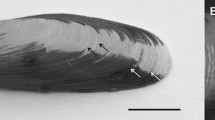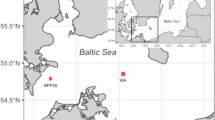Abstract
The age and shell growth rate of deep-sea hydrothermal bivalves were investigated for the first time using in situ chemical staining combined with high-resolution micro-increment analysis. A staining chamber developed for this purpose was applied to a patch of Bathymodiolus thermophilus mussels at 2,500 m depth at the 9°47′N vent field on the East Pacific Rise (EPR) in May 2010. This approach minimizes disturbance of the mussels in their habitat. Bathymodiolus thermophilus grows according to a circalunidian rhythm, with one increment formed each day, and displays tide-related growth rate variability. Based on the von Bertalanffy growth rate model, the largest shell collected (SL = 20.5 cm) would be 10.0 year old, with a growth rate of 4.2–1.1 cm year−1 as the shell ages. This fast growth rate is consistent with the instability of the environment in this section of the EPR and observed recolonization rates and could reflect a specific adaptation of this species.






Similar content being viewed by others
References
Baker MC, Ramirez-Llodra EZ, Tyler PA, German CR, Boetius A, Cordes EE, Dubilier N, Fisher CR, Levin LA, Metaxas A, Rowden AA, Santos RS, Shank TM, Van Dover CL, Young CM, Warén A (2010) Biogeography, ecology, and vulnerability of chemosynthetic ecosystems in the deep-sea. In: McIntyre A (ed) Life in the world’s oceans, vol 1. Wiley-Blackwell, Oxford, UK, pp 161–182
Barbin V, Ramseyer K, Elfman M (2008) Biological record of added manganese in seawater: a new efficient tool to mark in vivo growth lines in the oyster species Crassostrea gigas. Int J Earth Sci 97:193–199
Childress JJ (1988) Biology and chemistry of a deep-sea hydrothermal vent on the Galápagos Rift; the Rose Garden in 1985 an introduction. Deep Sea Res 35:1677–1680
Childress JJ, Fisher CR (1992) The biology of hydrothermal vent animals: physiology, biochemistry, and autotrophic symbioses. Oceanogr Mar Biol Annu Rev 30:337–441
Clark GR (1975) Periodic growth and biological rhythms in experimentally grown bivalves. In: Rosenberg R (ed) Growth rhythms and the history of the earth’s rotation. Wiley, New York, pp 103–117
Comtet T, Desbruyères D (1998) Population structure and recruitment in mytilid bivalves from the Lucky Strike and Menez Gwen hydrothermal vent fields (37°17′N and 37°50′N on the Mid-Atlantic Ridge). Mar Ecol Prog Ser 163:165–177
Fisher CR, Childress JJ, Arp AJ, Brooks JM, Distel D, Favuzzi JA, Felbeck H, Hessler R, Johnson KS, Kennicutt MC, Macko SA, Newton A, Powell MA, Somero GN, Soto T (1988) Microhabitat variation in the hydrothermal vent mussel, Bathymodiolus thermophilus, at the Rose Garden vent on the Galápagos Rift. Deep Sea Res 35:1769–1791
Ghil M, Allen RM, Dettinger MD, Ide K, Kondrashov D, Mann ME, Robertson A, Saunders A, Tian Y, Varadi F, Yiou P (2002) Advanced spectral methods for climatic time series. Rev Geophys 40:31–341
Hart DR, Chute AS (2009) Estimating von Bertalanffy growth parameters from growth increment data using a linear mixed-effects model, with an application to the sea scallop Placopecten magellanicus. ICES J Mar Sci 66:2165–2175
Hékinian R, Février M, Avedik F, Cambon P, Charlou JL, Needham HD, Raillard J, Boulègue J, Merlivat L, Moinet A, Manganini S, Lange J (1983) East Pacific Rise near 13°N: geology of new hydrothermal fields. Science 219:1321–1324
Johnson KS, Childress JJ, Beehler CL, Sakamoto CM (1994) Biogeochemistry of hydrothermal vent mussel communities: the deep-sea analogue to the intertidal zone. Deep Sea Res Part I Oceanogr Res Pap 41:993–1011
Jones DS (1983) Sclerochronology: reading the record of the molluscan shell. Am Sci 71:384–391
Kaehler S, McQuaid CD (1999) Use of the fluorochrome calcein as an in situ growth marker in the brown mussel Perna perna. Mar Biol 133:455–460
Keller GH, Anderson SH, Lavelle JW (1975) Near-bottom currents in the Mid-Atlantic Ridge rift valley. Can J Earth Sci 12:703–710
Kenk VC, Wilson BR (1985) A new mussel (Bivalvia, Mytilidae) from hydrothermal vents in the Galápagos Rift zone. Malacologia 26:253–271
Kim WS, Huh HT, Lee JH, Rumohr H, Koh CH (1999) Endogenous circatidal rhythm in the Manila clam Ruditapes philippinarum (Bivalvia: veneridae). Mar Biol 134:107–112
Langlet D, Alunno-Bruscia M, de Rafélis M, Renard M, Roux M, Schein E, Buestel D (2006) Experimental and natural cathodoluminescence in the shell of Crassostrea gigas from Thau lagoon (France): ecological and environmental implications. Mar Ecol Prog Ser 317:143–156
Lartaud F, de Rafelis M, Ropert M, Emmanuel L, Geairon P, Renard M (2010a) Mn labelling of living oysters: artificial and natural cathodoluminescence analyses as a tool for age and growth rate determination of C. gigas (Thunberg, 1793) shells. Aquaculture 300:206–217
Lartaud F, Chauvaud L, Richard J, Toulot A, Bollinger C, Testut L, Paulet YM (2010b) Experimental growth pattern calibration of Antarctic scallop shells (Adamussium colbecki, Smith 1902) to provide a biogenic archive of high-resolution records of environmental and climatic changes. J Exp Mar Biol Ecol 393:158–167
Le Bris N, Duperron S (2010) Chemosynthetic communities and biogeochemical energy pathways along the Mid-Atlantic Ridge: the case of Bathymodiolus azoricus. Geophys Monogr 188:409–429
Le Bris N, Govenar B, Le Gall C, Fisher CR (2006) Variability of physico-chemical conditions in 9°50′N EPR diffuse flow vent habitats. Mar Chem 98:167–182
Lutz RA, Rhoads DC (1977) Anaerobiosis and a theory of growth line formation. Science 198:1222–1227
Lutz RA, Jablonski D, Rhoads DC, Turner RD (1980) Larval dispersal of a deep-sea hydrothermal vent bivalve from the Galápagos rift. Mar Biol 57:127–133
Lutz RA, Fritz LW, Cerrato RM (1988) A comparison of bivalve (Calyptogena magnifica) growth at two deep-sea hydrothermal vents in the eastern Pacific. Deep Sea Res 35:1793–1810
Mahé K, Bellamy E, Lartaud F, de Rafélis M (2010) Calcein and manganese experiments for marking the shell of the common cockle (Cerastoderma edule): tidal rhythm validation of increments formation. Aquat Living Resour 23:239–245
Mutvei H, Westermark T, Dunca E, Carell B, Forberg S, Bignert A (1994) Methods for the study of environmental changes using the structural and chemical information in molluscan shells. Bull Inst Oceanogr Monaco 13:163–186
Nees HA, Moore TS, Mullaugh KM, Holyoke RR, Janzen CP, Ma S, Metzger E, Waite TJ, Yücel M, Lutz RA, Shank TM, Vetriani C, Nuzzio DB, Luther GW (2008) Hydrothermal vent mussel habitat chemistry, pre and post-eruption at 9°50′ north on the East Pacific Rise. J Shellfish Res 27:169–175
Raulfs EC, Macko SA, Van Dover CL (2004) Tissue and symbiont condition of mussels (Bathymodiolus thermophilus) exposed to varying levels of hydrothermal activity. J Mar Biol Assoc UK 84:229–234
Rhoads DC, Lutz RA, Revelas EC, Cerrato RM (1981) Growth of bivalves at deep-sea hydrothermal vents along the Galápagos Rift. Sciences 214:911–913
Rhoads DC, Lutz RA, Cerrato RM, Revelas EC (1982) Growth and predation activity at deep-sea hydrothermal vents along the Galápagos Rift. J Mar Res 40:503–516
Richardson CA (1996) Exogenous or endogenous control of growth band formation in subtidal bivalve shells? Bull Inst Oceanogr Monaco 14:133–141
Richardson CA (2001) Molluscs as archive of environmental change. Oceanogr Mar Biol 39:103–164
Richardson CA, Crisp DJ, Runham NW (1980) An endogenous rhythm in shell deposition in Cerastoderma edule. J Mar Biol Assoc UK 60:991–1004
Roux M, Rio M, Schein E, Lutz RA, Fritz LW, Ragone LM (1989) In situ measurements of bivalve and tube worm growth-rate and of shell corrosion at the 13°N hydrothermal site (East Pacific Rise). C R Acad Sci Ser III Sci Vie 308:495–500
Scheirer DS, Shank TM, Fornari DJ (2006) Temperature variations at diffuse and focused flow hydrothermal vent sites along the northern East Pacific Rise. Geochem Geophys Geosyst 7:1–23
Schöne BR (2008) The curse of physiology-challenges and opportunities in the interpretation of geochemical data from mollusk shells. Geo-Mar Lett 28:269–285
Schöne BR, Giere O (2005) Growth increments and stable isotope variation in shells of the deep-sea hydrothermal vent bivalve mollusk Bathymodiolus brevior from the North Fiji Basin, Pacific Ocean. Deep Sea Res Part I Oceanogr Res Pap 52:1896–1910
Schöne BR, Dunca E, Fiebig J, Pfeiffer M (2005) Mutvei’s solution: an ideal agent for resolving microgrowth structures of biogenic carbonates. Palaeogeogr Palaeoclimatol Palaeoecol 228:149–166
Schöne BR, Tanabe K, Dettman DL, Sato S (2003) Environmental controls on shell growth rates and δ18O of the shallow-marine bivalve mollusk Phacosoma japonicum in Japan. Mar Biol 142:473–485
Shank TM, Fornari DJ, Von Damm KL, Lilley MD, Haymon RM, Lutz RA (1998) Temporal and spatial patterns of biological community development at nascent deep-sea hydrothermal vents (9°50′N, East Pacific Rise). Deep Sea Res Part II Top Stud Oceanogr 45:465–515
Smith KL (1985) Deep-sea hydrothermal vent mussels: nutritional state and distribution at the Galápagos Rift. Ecology 66:1067–1080
Soule SA, Fornari DJ, Perfit MR, Rubin KH (2007) New insights into mid-ocean ridge volcanic processes from the 2005–2006 eruption of the East Pacific Rise, 9°46′N-9°56′N. Geology 35:1079–1082
Steffani CN, Branch GM (2003) Growth rate, condition, and shell shape of Mytilus galloprovincialis: responses to wave exposure. Mar Ecol Prog Ser 246:197–209
Stroup DF, Bohnenstiehl DR, Tolstoy M, Waldhauser F, Weekly RT (2007) Pulse of the seafloor: tidal triggering of microearthquakes at 9°50′N East Pacific Rise. Geophys Res Lett 34:1–6
Tada Y, Fujikura K, Oguri K, Kitazato H, Tanabe K (2010) In situ fluorochrome calcein marking of deep-sea molluscs using a new growth chamber. Aquat Ecol 44:217–222
Thomson DJ (1982) Spectrum estimation and harmonic analysis. Proc IEEE 70:1055–1096
Tivey MK, Bradley AM, Joyce TM, Kadko D (2002) Insights into tide-related variability at seafloor hydrothermal vents from time-series temperature measurements. Earth Planet Sci Lett 202:693–707
Tunnicliffe V (1991) The biology of hydrothermal vents: ecology and evolution. Oceanogr Mar Biol Annu Rev 29:319–407
Van Dover CL (1995) Ecology of Mid-Atlantic Ridge hydrothermal vents. Geol Soc Spec Publ 87:257–294
Van Dover CL (2000) The ecology of deep-sea hydrothermal vents. Princeton, New Jersey
Van Dover CL, Jenkins CD, Turnipseed M (2001) Corralling of larvae in the deep-sea. J Mar Biol Assoc UK 81:823–826
Walford LA (1946) A new graphic method of describing the growth of animals. Biol Bull 90:141–147
Acknowledgments
We kindly thank captain and crew of the R/V l’Atalante, the Nautile operation group, from IFREMER, and the MESCAL scientific party for their support and help during the cruise. We also acknowledge Lionel Feuillassier and Mylene Lorre for informatic support and Nicolas Ferrer (UMS 2348) for his help in the conception and realization of the staining chamber. We greatly appreciate the help of the three anonymous reviewers whose comments greatly improved this manuscript. We also thank Jennifer Coston-Guarini for her essential support in the improvement and editing the manuscript. The study benefited from the joint support of Foundation TOTAL to the chair “Extreme environment, biodiversity and global change” and from financial support of CNRS to the deep-sea cruises. K. Nedoncelle PhD grant is supported by MESR via the Doctoral Scholl “Science de l’Environnement d’Ile de France” ED129.
Author information
Authors and Affiliations
Corresponding author
Additional information
Communicated by J. P. Grassle.
Electronic supplementary material
Below is the link to the electronic supplementary material.
Rights and permissions
About this article
Cite this article
Nedoncelle, K., Lartaud, F., de Rafelis, M. et al. A new method for high-resolution bivalve growth rate studies in hydrothermal environments. Mar Biol 160, 1427–1439 (2013). https://doi.org/10.1007/s00227-013-2195-7
Received:
Accepted:
Published:
Issue Date:
DOI: https://doi.org/10.1007/s00227-013-2195-7




